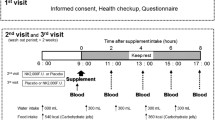Abstract
The aim of the study was to compare in a single trial, using identical methodology, the pharmacokinetic properties and the effect on the hemostatic system of saruplase (unglycosylated scu-PA) and urokinase (glycosylated tcu-PA). Twenty-four patients with an acute myocardial infarction were either treated with saruplase (n = 12; 20 mg IV bolus followed by a 60 mg infusion for 60 minutes) or urokinase (n = 12; 1.5 million IU IV bolus followed by 1.5 million IU infusion for 60 minutes). Blood samples from saruplase-treated patients were analyzed for u-PA antigen and total u-PA and tcu-PA activities; those from urokinase-treated patients for u-PA antigen and tcu-PA activity. The effect of treatment on, including recovery of, plasma α2-antiplasmin, fibrinogen, and plasminogen was examined in both groups. The total clearance of urokinase (179 ± 55 ml/ min) is about half that of saruplase (406 ± 154 ml/min), and the mean residence time of urokinase (59.1 ± 22.5 minutes) is nearly twice that of saruplase (28.3 ± 7.8 minutes), which results in a slower elimination of urokinase from plasma. Whether differences in the pharmacokinetic behavior of the unglycosylated saruplase and the glycosylated urokinase observed in this study are due to the difference in glycosylation or to other factors is not resolved. The systemic effect of saruplase on α2,-antiplasmin, fibrinogen, and plasminogen is similar to that of urokinase, although retarded.
Similar content being viewed by others
References
PRIMI Trial Study Group. Randomized double-blind trial of recombinant pro-urokinse against streptokinase in acute myocardial infarction. Lancet 1989;1:863–868.
Gurewich V, Pannell R, Louie S, Kelley P, Suddith RK, Greenlee R. Effective and fibrin specific clot lysis by a zymogen precursor form of urokinse (pro-urokinase). J Clin Invest 1984;73:1731–1739.
Hanbücken FW, Schneider J, Günzler WA, Friderichs E, Giertz H, Flohé L. Selective fibrinolytic activity of recombinant non-glycosylated human pro-urokinase (single chain urokinse type plasminogen activator) from bacteria. Drug Res 1987;37(II):993–997.
Flameng W, Vanhaecke J, Stump DC, et al. Coronary thrombolysis by intravenous infusion of recombinant single chain urokinase type plasminogen activator or recombinant urokinase in baboons. Effect on regional blood flow, infarct size and haemostasis. J Am Coll Cardiol 1986;8:118–124.
De Boer A, Kluft C, Gerloff J, et al. Pharmacokinetics of saruplase, a recombinant unglycosylated human singlechain urokinase-type plasminogen activator and its effect on fibrinolytic and haemostatic parameters in healthy male subjects. Thromb Haemost 1993;70:320–325.
Koster RW, Cohen AF, Hopkins GR, Beier H, Günzler WA, van der Wouw PA. Pharmacokinetics and pharmacodynamics of saruplase, an unglycosylated single-chain urokinse-type plasminogen activator, in patients with acute myocardial infarction. Thromb Haemost 1994;71:740–744.
Günzler WA, Beier H, Flohé L. Activity and antigen of saruplase and two chain urokinase related plasminogen activator are stabilized by a combination of aprotinin and benzamidine. Fibrinolysis 1990;4(Supp 2):145–147.
Clauss VA. Gerinnungsphysiologische Schnellmethode zur Bestimmung des Fibrinogens. Acta Haematol 1957;17:237–246.
Heinzel G. Data analysis and evaluation techniques. In: Bozler G, van Rossum IM, eds. Pharmacokinetics During Drug Development. Stuttgart:-G. Fischer, 1982:207–208.
Pannell R, Gurewich V. Activation of plasminogen by single-chain urokinase or by two chain urokinase-A demonstration that single chain urokinase has a low catalytic activity. Blood 1987;69:22–26.
Lenich C, Pannell R, Henkin J, Gurewich V. The influence of glycosylation on the catalytic and fibrinolytic properties of pro-urokinase. Thromb Haemost 1992;68:539–544.
Collen D, De Cock F, Lijnen HR. Biological and thrombolytic properties of proenzyme and active forms of human urokinase—II. Turnover of natural and recombinant urokinase in rabbits and squirrel monkeys. Thromb Haemost 1984;52;1:24–26.
Kuiper J, Rijken DC, de Munk GAW, van Berkel TJC. In vivo and in vitro interaction of high and low molecular weight single-chain urokinase type plasminogen activator with rat liver cells. J Biol Chem 1991;267:1589–1595.
Hiramatsu R, Kasai S, Amatsuji Y, et al. Effect of deletion of epidermal growth factor-like domain on plasma clearance of pro-urokinase. Fibrinolysis 1989;3:147–151.
Kounass MZ, Henkin J, Argraves WS, Strickland DK. Low density lipoprotein receptor related protein/α2-macroglobulin receptor mediates cellular uptake of pro-urokinase. J Biol Chem 1993;268:21862–21867.
Author information
Authors and Affiliations
Rights and permissions
About this article
Cite this article
Poeppelmeier, J., Beier, H., Carlsson, J. et al. Comparison of the pharmacokinetics and effects on the hemostatic system of saruplase and urokinase in patients with acute myocardial infarction. J Thromb Thrombol 3, 385–390 (1996). https://doi.org/10.1007/BF00133082
Received:
Accepted:
Issue Date:
DOI: https://doi.org/10.1007/BF00133082




